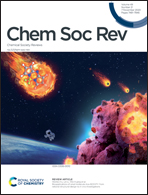Ionic liquid lubricants: when chemistry meets tribology†
Abstract
Ionic liquids (ILs) have emerged as potential lubricants in 2001. Subsequently, there has been tremendous research interest in ILs from the tribology society since their discovery as novel synthetic lubricating materials. This also expands the research area of ILs. Consistent with the requirement of searching for alternative and eco-friendly lubricants, IL lubrication will experience further development in the coming years. Herein, we review the research progress of IL lubricants. Generally, the tribological properties of IL lubricants as lubricating oils, additives and thin films are reviewed in detail and their lubrication mechanisms discussed. Considering their actual applications, the flexible design of ILs allows the synthesis of task-specific and tribologically interesting ILs to overcome the drawbacks of the application of ILs, such as high cost, poor compatibility with traditional oils, thermal oxidization and corrosion. Nowadays, increasing research is focused on halogen-free ILs, green ILs, synthesis-free ILs and functional ILs. In addition to their macroscopic properties, the nanoscopic performance of ILs on a small scale and in small gaps is also important in revealing their tribological mechanisms. It has been shown that when sliding surfaces are compressed, in comparison with a less polar molecular lubricant, ion pairs resist “squeeze out” due to the strong interaction between the ions of ILs and oppositely charged surfaces, resulting in a film that remains in place at higher shear forces. Thus, the lubricity of ILs can be externally controlled in situ by applying electric potentials. In summary, ILs demonstrate sufficient design versatility as a type of model lubricant for meeting the requirements of mechanical engineering. Accordingly, their perspectives and future development are discussed in this review.



 Please wait while we load your content...
Please wait while we load your content...